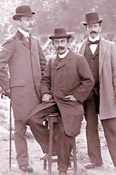Lightyears Collection
Philippe Chuit
(1866-1939)
Philippe Chuit has been called "a perfumer for perfumers." A chemist, Chuit was responsible for the creation (and for supervising the creation) of a number of perfumery bases and specialty chemicals which helped fuel the golden age of perfumery. In 1895, in a small workshop near Geneva, Switzerland, Chuit began working on the synthesis of new aroma chemicals in partnership with Martin Naef, who provided capital. By 1897, Chuit & Naef had twenty employees and began construction on a new facility. In 1900, Chuit and Naef were joined by Chuit's brother-in-law, master salesman, Fred Firmenich, who ultimately took over the direction of the company and gave it his own name — the name under which it is known today. Chuit was born in Geneva on May 1st, 1866 to Jean François and Rose-Jeanne (Rossier) Chuit. Chuit's father was a gardener. While today we might puzzle at the connection between gardening and perfumery science, consider how many French perfumers grew up in the Grasse region of France, known for it's abundance of flowers used in perfumery. Chuit married Thérése Firmenich, thereby acquiring Fred Firmenich as a brother-in-law. Their father, Charles, was an agent for the Bayer company, selling colorants. Chuit, who received his doctorate in 1889, remained a chemist all his life. In 1910 he sold his business interest in the company to Firmenich but continued to work for Firmenich as an employee. Even after Chuit recruited Hungarian chemist, Leopid Ruzicka, in 1921 to take over the direction of the company's R&D program, Chuit continued working for the company (now called Firmenich) for another ten years. Chuit's choice of Ruzicka as R&D director was a wise one. In 1939, Ruzicka was awarded the Nobel Prize for Chemistry. In 1895, Chuit, using a new method of synthesis, created Vanillian, a sweet, vanillic, woody note now used as a modifier in many perfumes. In 1902, Chuit created Violettone, a iris, woody note, and Dianthine, a spicy, carnation note. In 1903, Chuit introduced Iralia, a soft floral, woody note (methyl-ionone). Cyclosia, a lilly of the valley note, (Hydroxycitronellal) appeared in 1908. François Coty's L'Origan (1905) made use of both Violettone and Iralia, an indication of just how "cutting edge" Coty was as a perfumer and Chuit as a synthetic perfumery raw material creator. |
If you have any information you would like to share with us about Fred Firmenich, Martin Naef, Philippe Chuit or perfumery materials created by Chuit & Naef or Firmenich, please use the message sender below.
|
|


Philip Goutell
Lightyears, Inc.


